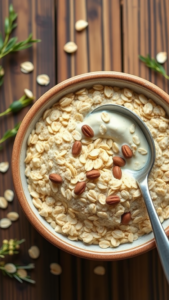Can You Have Oatmeal on a Keto Diet? Understanding the Carbohydrate Factors
When you’re on a keto diet, the main goal is to keep your carbohydrate intake very low while increasing fats and moderate protein. But this raises a common question: Can you have oatmeal on a keto diet? Let’s dive into the carbohydrate factors and see whether oatmeal can fit into your keto lifestyle.
The ketogenic diet typically limits daily carb intake to about 20-50 grams. This range is critical for getting your body into ketosis, where it burns fat for energy instead of carbohydrates. Understanding how oatmeal fits into this is essential for anyone considering this popular breakfast option.
Oatmeal is often hailed for its nutritional benefits. However, it is also known for its higher carbohydrate content. A standard serving of plain, cooked oatmeal (about 1 cup) can contain around 27 grams of carbohydrates. This is why many people on a keto diet hesitate when it comes to including oatmeal in their meals.
The key to determining if you can include oatmeal lies in the type of oatmeal and your daily macronutrient goals. Let’s break down the carbohydrate content of different types of oatmeal:
| Type of Oatmeal | Carbohydrates (per 1 cup cooked) | Fiber (per 1 cup cooked) | Net Carbs (Carbs – Fiber) |
|---|---|---|---|
| Rolled Oats | 27g | 4g | 23g |
| Steel-Cut Oats | 30g | 5g | 25g |
| Instant Oats | 29g | 4g | 25g |
From this table, it’s easy to see that regardless of the type, oatmeal’s carbohydrate count is high. This can quickly eat into your daily carb limit on a keto diet. You may wonder if there’s a way to enjoy oats while maintaining ketosis.
One strategy is to look for alternatives. For example, you can consider oatmeal substitutes that have lower carbohydrate levels. Here are a few options:
- Coconut Flour: This flour is very low in carbs and high in fiber, making it a keto-friendly alternative. You can make a porridge-like dish from it.
- Chia Seeds: These seeds are packed with omega-3 fatty acids and fiber. They expand in water, making a filling pudding that satisfies breakfast cravings.
- Ground Flaxseed: Similar to chia seeds, flaxseed can be mixed with water to create a filling, nutritious breakfast.
In addition to alternatives, you can also modify how you consume oatmeal if you really want it as part of your diet. Consider reducing the portion size significantly and offsetting it with low-carb toppings like nuts or unsweetened almond milk. However, it is crucial to keep track of your overall carb intake.
It’s also beneficial to remember that some people experience different effects when eating certain foods on keto. You may find that oatmeal affects your blood sugar levels, which can be counterproductive for maintaining ketosis. Keeping a food diary or using an app can help you monitor how your body reacts.
Ultimately, the question of whether you can have oatmeal on a keto diet depends heavily on your personal carb limit and how your body responds to it. Many keto practitioners opt to avoid oatmeal altogether due to its high carbs, while others might indulge in a small amount on occasion. It’s all about balance and finding what works for you.
If you’re tempted by the idea of having oatmeal for breakfast on a keto diet, consider exploring lower-carb alternatives or small portions, while being conscious of your daily carbohydrate needs. Listening to your body as you adjust your diet can lead to better results and a more enjoyable eating experience.
Low-Carb Alternatives to Oatmeal for Keto Enthusiasts
If you’re on a keto diet, you might be wondering if oatmeal fits into your meal planning. Traditional oats are high in carbohydrates, which is a big no for keto. But don’t worry; there are plenty of delicious low-carb alternatives that can give you the warmth and satisfaction of oatmeal without knocking you out of ketosis.
First, let’s understand why oatmeal isn’t suitable for a keto lifestyle. A typical serving of cooked oatmeal contains around 27 grams of carbs, which can quickly push you over your daily limit. Instead of reaching for those oats, consider these fantastic low-carb options.
Chia Seed Pudding
Chia seeds are tiny powerhouses of nutrition. When soaked in liquid, they expand and take on a pudding-like texture, similar to oatmeal. Here’s how to make it:
- Combine: Mix 3 tablespoons of chia seeds with 1 cup of unsweetened almond milk.
- Sweeten: Add a low-carb sweetener, like stevia or erythritol, to taste.
- Flavor: Mix in some vanilla extract or a tablespoon of cocoa powder for extra flavor.
- Chill: Let it sit in the refrigerator for a few hours or overnight.
This dish provides healthy fats, fiber, and only about 6 grams of net carbs per serving. It’s also versatile; you can top it with berries or nuts if your daily carb count allows.
Flaxseed Meal
Flaxseed is another fantastic alternative that is low in carbs and high in omega-3 fatty acids. You can make a comforting porridge using flaxseed meal:
- Mix: Combine 1/4 cup flaxseed meal with 1 cup of water or almond milk in a saucepan.
- Cook: Heat over medium heat until thickened, stirring throughout.
- Add: Sweetener and spices, like cinnamon or nutmeg, to taste.
This flaxseed porridge contains about 2 grams of net carbs and is rich in fiber, helping you feel full longer.
Egg and Cheese Breakfast Bowl
If you’re craving something savory, consider an egg and cheese breakfast bowl. This dish is simple but satisfying:
- Ingredients: Scrambled eggs, shredded cheese, diced bell peppers, and spinach.
- Instructions: Cook the ingredients together in a skillet until the eggs are fluffy and everything is heated through.
Not only is this low in carbs, but it offers a great source of protein and healthy fats, keeping your energy levels up throughout the day.
Coconut Flour Porridge
Coconut flour is another low-carb food that can be transformed into a delicious porridge.
- Whisk: In a bowl, mix 1/4 cup of coconut flour with 1 cup of unsweetened almond milk.
- Cook: Heat in a saucepan until it thickens. Stir constantly.
- Additions: Stir in a sweetener and top it with coconut flakes or nuts.
This coconut flour porridge contains around 5 grams of net carbs and provides a hint of sweetness that usually pairs well with breakfast.
Zucchini Oatmeal
If you’re looking for a lower-carb way to mimic the texture of oatmeal, zucchini can be a great base:
- Grate: 1 medium zucchini and place it in a pan with some butter.
- Cook: Sauté until soft, then add spices like cinnamon and a touch of sweetener.
- Finish: Stir in some almond flour for added thickness.
Zucchini oatmeal is surprisingly filling and only contains about 3 grams of net carbs per serving.
Comparison Table of Alternatives
| Alternative | Net Carbs (per serving) | Key Nutrients |
|---|---|---|
| Chia Seed Pudding | 6 grams | Fiber, Omega-3 fatty acids |
| Flaxseed Meal Porridge | 2 grams | Fiber, Omega-3 fatty acids |
| Egg and Cheese Bowl | Approx. 2 grams | Protein, Healthy fats |
| Coconut Flour Porridge | 5 grams | Fiber, Medium-chain triglycerides |
| Zucchini Oatmeal | 3 grams | Vitamins, Fiber |
These low-carb alternatives to oatmeal not only satisfy your morning cravings but also keep you on track with your keto diet. Experiment with these recipes and find your favorites! Enjoy your meals while staying healthy and achieving your dietary goals.
The Nutritional Profile of Oatmeal Versus Keto-Friendly Options
When it comes to breakfast options, oatmeal is a popular choice for many due to its nutrient-rich profile and health benefits. However, if you are following a keto diet, you may wonder how it stacks up against keto-friendly alternatives. Let’s explore the nutritional differences between oatmeal and other options that fit within a low-carb lifestyle.
The Nutritional Profile of Oatmeal
Oatmeal is mainly made from oats, which are whole grains packed with essential nutrients. Here’s a breakdown of its nutritional composition per 100 grams of cooked oatmeal:
| Nutrient | Amount |
|---|---|
| Calories | 71 |
| Carbohydrates | 12 g |
| Dietary Fiber | 1.7 g |
| Protein | 2.5 g |
| Fat | 1.5 g |
| Sugar | 0.5 g |
As you can see, oatmeal is relatively high in carbohydrates. This could make it challenging to fit into a strict ketogenic diet, where the goal is to limit daily carbohydrate intake to about 20-50 grams.
Keto-Friendly Alternatives
For those on a ketogenic diet, it is essential to choose options that are low in carbs yet satisfying. Below are several keto-friendly alternatives to traditional oatmeal, along with their nutritional highlights:
- Chia Seed Pudding
Nutritional Profile (per 100 g):- Calories: 486
- Carbohydrates: 42 g
- Dietary Fiber: 34 g
- Protein: 16 g
- Fat: 31 g
- Flaxseed Meal
Nutritional Profile (per 100 g):- Calories: 534
- Carbohydrates: 29 g
- Dietary Fiber: 27 g
- Protein: 18 g
- Fat: 42 g
- Almond Meal
Nutritional Profile (per 100 g):- Calories: 600
- Carbohydrates: 20 g
- Dietary Fiber: 10 g
- Protein: 21 g
- Fat: 53 g
These alternatives offer a satisfying breakfast or snack while helping you stay within your carbohydrate limits. They are also rich in healthy fats and fiber, making them excellent choices for sustained energy.
Comparative Analysis
To compare oatmeal with these keto options effectively, consider the following:
| Food Item | Calories (per 100 g) | Carbs (g) | Fat (g) | Protein (g) |
|---|---|---|---|---|
| Oatmeal | 71 | 12 | 1.5 | 2.5 |
| Chia Seeds | 486 | 42 | 31 | 16 |
| Flaxseed Meal | 534 | 29 | 42 | 18 |
| Almond Meal | 600 | 20 | 53 | 21 |
While oatmeal provides fewer calories and carbohydrates, it doesn’t align well with the ketotic state you aim for in a ketogenic diet. Keto-friendly options are generally richer in healthy fats and have different macronutrient ratios that suit your lifestyle better.
While oatmeal is a nutritious choice for many, it does not fit neatly into a ketogenic diet. Instead, explore the variety of keto-friendly alternatives that can enhance your meals and keep you on track. By making informed choices, you can enjoy satisfying breakfasts without compromising your dietary goals.
Creative Ways to Enjoy Breakfast on a Keto Diet
Breakfast can be a challenge when you’re following a keto diet. You want to enjoy delicious meals while keeping your carbohydrate intake low. Luckily, there are many creative ways to kickstart your day without sacrificing taste. Let’s explore some innovative breakfast ideas that fit perfectly into your keto lifestyle.
Low-Carb Egg Creations
Eggs are a staple on the keto diet because they are low in carbs and high in healthy fats. Here are some of the many ways you can get creative with eggs:
- Cloud Eggs: Separate the egg whites from yolks, whip the whites until fluffy, then bake with the yolk placed back in the center for a visually appealing creation.
- Egg Muffins: Mix eggs with your favorite veggies and cheese, pour into muffin tins, and bake. These are great for meal prep!
- Shakshuka: Poach eggs in a rich tomato sauce seasoned with bell peppers and spices. This dish packs flavor and nutrition.
Keto Smoothies
Who says smoothies can’t be keto-friendly? You can whip up a smoothie that fits your diet without the sugar spikes!
- Green Keto Smoothie: Blend spinach, avocado, coconut milk, and a scoop of protein powder for a creamy treat.
- Berry Blast: Use unsweetened almond milk, spinach, and a handful of raspberries or strawberries for a refreshing option. Berries are lower in carbs compared to other fruits.
Creative Alternatives to Oatmeal
If you miss the warm and comforting feel of oatmeal, here are some great substitutes that provide the same texture and satisfaction without the carbs:
- Chia Seed Pudding: Mix chia seeds with unsweetened almond milk and let them soak overnight. Add some cinnamon and a few berries to flavor this satisfying dish.
- Flaxseed Meal Porridge: Combine flaxseed meal with boiling water and let it sit until it thickens. Flavor it with vanilla extract and top with nuts or seeds.
- Coconut Flour Porridge: Stir coconut flour into water or almond milk and cook it on low heat until it thickens, adding cinnamon or a sweetener if desired.
Deli-Style Breakfasts
Mixing breakfast with flavors of lunch can add excitement to your morning. Here are some ideas:
- Keto Breakfast Wrap: Use a low-carb tortilla or lettuce wrap, filled with turkey, cheese, and avocado slices.
- Charcuterie Board: Create a breakfast charcuterie board with cheese, olives, hard-boiled eggs, and deli meats. This can be both fun and fulfilling!
- Tuna or Chicken Salad: Incorporate these protein-packed salads on a bed of spinach for a filling breakfast that’s satisfying.
Delicious Keto Pancakes
Pancakes can still be on the menu! Here are some keto-friendly options that taste just as good:
- Almond Flour Pancakes: Combine almond flour, eggs, and cream cheese for a fluffy pancake option that’s low in carbohydrates.
- Coconut Flour Pancakes: Mix coconut flour, eggs, and some baking powder. These pancakes excel with a drizzle of sugar-free syrup.
Nut Butter Goodness
Nut butter can elevate your breakfast to a whole new level, providing healthy fats and delicious flavors:
- Nut Butter and Celery: Spread almond butter or peanut butter on celery sticks for a crunchy and satisfying snack.
- Smooth Nut Butter Cups: Mix various nut butters with cocoa powder and chill them for delicious breakfast treats on the go.
With these creative ideas, breakfast on a keto diet can be both enjoyable and diverse. You can keep your meal prep exciting while sticking to low-carb options. Try out different combinations and find what fits your taste preferences the best. By thinking outside the box, you’ll make your mornings delicious and support your keto journey.
Tips for Managing Cravings While Following Keto Guidelines
Following a keto diet can be a rewarding journey, but it often comes with cravings that can challenge your commitment. Understanding how to manage these cravings is key to staying on track. Here are effective tips to help you overcome cravings while adhering to keto guidelines.
Understand Your Cravings
The first step to managing cravings is understanding their root cause. Cravings can occur due to various factors, including:
- Emotional Triggers: Stress, boredom, or sadness can lead to cravings for comfort foods.
- Hunger: When you don’t eat enough during the day, you may crave high-carb foods.
- Habit: Sometimes, cravings are driven by routines, such as snacking during a TV show.
Keep Yourself Hydrated
Water is one of the best tools in your arsenal. Sometimes, what feels like a craving is actually thirst. Keeping hydrated can help mitigate these feelings.
- Drink Water: Aim for at least eight glasses a day. Adding lemon or herbs can enhance the flavor.
- Herbal Teas: Unsweetened herbal teas can provide warmth and comfort without carbs.
Incorporate Healthy Fats
Healthy fats are a cornerstone of the keto diet and can help keep cravings at bay. They provide satiety and help your body feel satisfied.
- Avocado: This is a high-fat fruit that can be eaten on its own or added to meals.
- Nuts and Seeds: Keep a small portion handy for snacking. Just watch the servings as they can be calorie-dense.
- Nut Butters: These can curb cravings and are a delicious way to get healthy fats.
Plan Your Meals and Snacks
Planning your meals in advance can help you stay focused and prevent impulsive decisions that lead to carb-packed snacks. Consider creating a weekly meal plan that includes:
- Low-Carb Snacks: Prepare snacks such as cheese slices, hard-boiled eggs, or celery sticks with cream cheese.
- Portion Control: Portion out your servings in advance to avoid overindulging.
Engage in Distractions
When cravings hit, try to distract yourself with activities that occupy your mind and body. Here are some ideas:
- Exercise: Go for a walk or do a quick workout to shift your focus.
- Hobbies: Engage in a hobby like painting, crossword puzzles, or reading.
- Socialize: Call a friend to chat or join an online community to share your experiences.
Consider Keto-Friendly Treats
If you’re finding it hard to resist certain cravings, it’s okay to have keto-friendly treats in moderation. You can make or buy:
- Keto Desserts: Look for recipes that use almond flour, coconut flour, or erythritol.
- Dark Chocolate: Choose chocolate that has at least 70% cocoa to ensure low sugar content.
Stay Mindful
Practicing mindfulness involves paying attention to your feelings and actions regarding food. Here’s how:
- Journaling: Keep a food journal to track your cravings and what triggers them.
- Mindful Eating: When you eat, focus on your food rather than multitasking. This helps you appreciate and enjoy your meals more.
Seek Support
Having a support system can make a significant difference in how you manage cravings. Look for:
- Accountability Partners: Connect with a friend or family member who follows keto.
- Online Communities: Join forums or social media groups focused on keto living.
Remember Your Goals
Keep reminding yourself why you started the keto journey. Visualizing your goals can help maintain your motivation. Write down your reasons for choosing keto and review them whenever you feel tempted.
| Tip | Description |
|---|---|
| Hydration | Drink plenty of water and herbal teas. |
| Healthy Fats | Include avocados, nuts, and nut butters in your diet. |
| Meal Planning | Prepare low-carb meals and snacks in advance. |
| Mindful Eating | Focus on eating and enjoy each bite. |
By employing these practical strategies, you can effectively manage cravings while sticking to your keto diet. Remember, the journey is about finding balance and what works best for you!
Conclusion
Balancing your breakfast choices while following a keto diet can be a bit challenging, especially when it comes to oatmeal. While traditional oatmeal is rich in fiber and nutrients, its high carbohydrate content can make it unsuitable for a strict keto regimen. However, understanding the carbohydrate factors gives you insights into how it fits into your overall dietary goals.
If you’re craving the comforting warmth of oatmeal, consider low-carb alternatives like chia seed pudding, flaxseed meal porridge, or even cauliflower rice breakfast bowls. These options can replicate the texture and satisfaction of oatmeal while keeping your carb intake in check. Exploring these keto-friendly substitutes not only helps you stay within your limits but also adds variety to your meals.
When comparing the nutritional profiles, it becomes evident that many low-carb options offer essential nutrients with fewer carbs, making them more aligned with keto guidelines. Additionally, getting creative with your breakfast can make sticking to a keto diet more enjoyable. Think of adding a scoop of nut butter to your chia pudding or topping a flaxseed bowl with berries for a burst of flavor.
Managing cravings is another essential aspect of maintaining your commitment to keto. healthy fats and protein into your meals can help curb those urges while keeping you satisfied. So, whether you seek a creamy, nutty breakfast or something refreshing, there’s a world of keto-friendly options waiting for you. With a bit of creativity and a focus on low-carb alternatives, you can enjoy breakfast without compromising your dietary goals.




